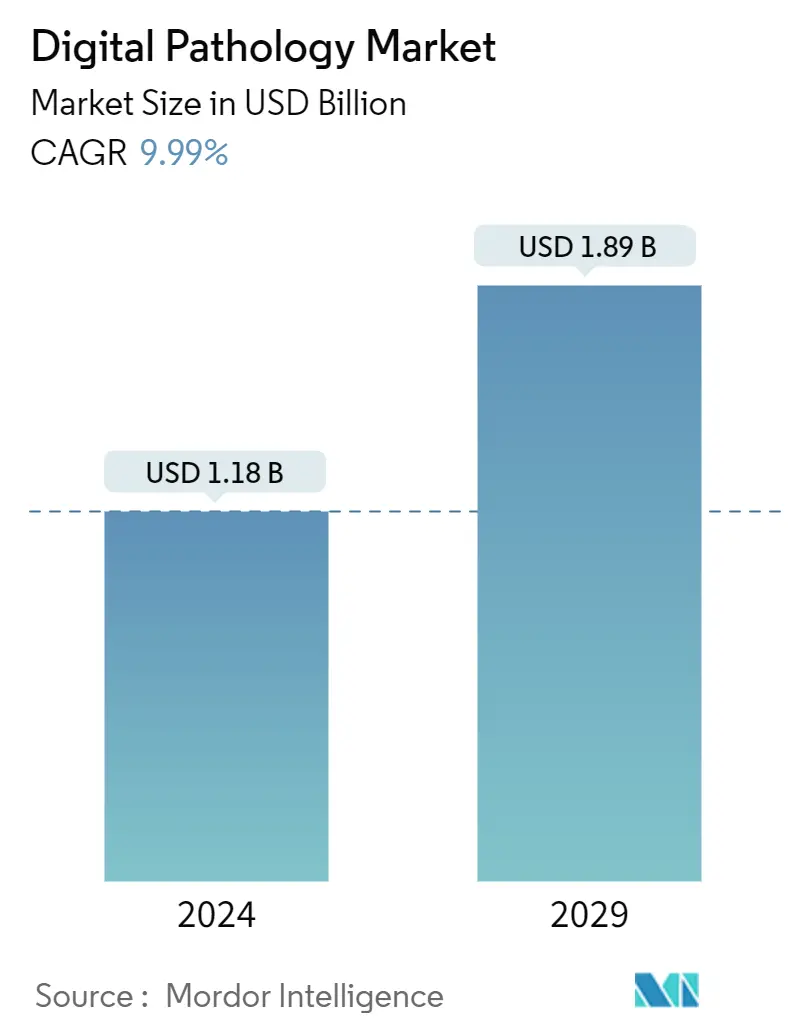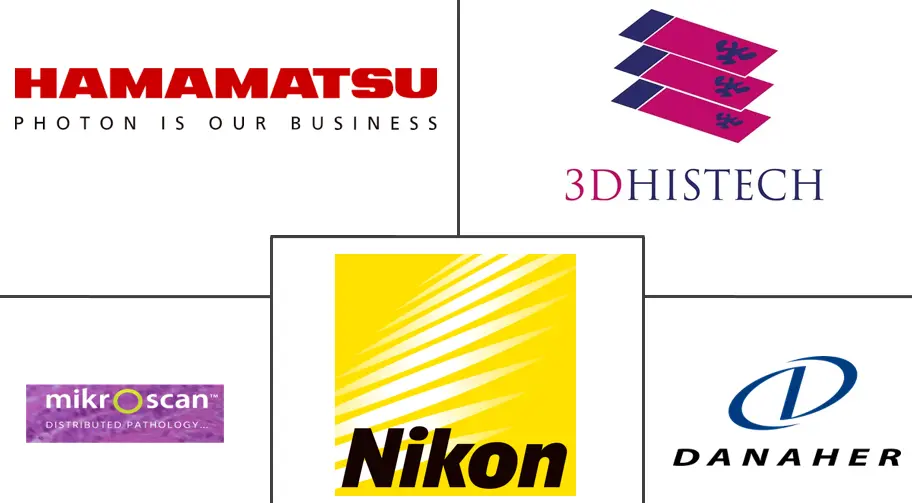Market Size of Digital Pathology Industry

| Study Period | 2019 - 2029 |
| Market Size (2024) | USD 1.18 Billion |
| Market Size (2029) | USD 1.89 Billion |
| CAGR (2024 - 2029) | 9.99 % |
| Fastest Growing Market | Asia-Pacific |
| Largest Market | North America |
Major Players
*Disclaimer: Major Players sorted in no particular order |
Digital Pathology Market Analysis
The Digital Pathology Market size is estimated at USD 1.18 billion in 2024, and is expected to reach USD 1.89 billion by 2029, growing at a CAGR of 9.99% during the forecast period (2024-2029).
During the COVID-19 pandemic, government organizations in various countries, research institutes, and many biotech and pharmaceutical firms focused on effective and rapid technologies for the fast diagnosis of COVID-19 and to develop vaccines/new therapeutics to overcome the pandemic situation. The COVID-19 pandemic challenged diagnostic services when many histopathology departments already faced a diminishing workforce and increasing workload. Also, the COVID-19 pandemic in 2020, had a profound impact on routine pathology services. Digital pathology played a key role in safeguarding clinical services and pathology-based research during the pandemic 2020. For instance, according to an article published by BMJ Publishing Group Ltd & Association of Clinical Pathologists, in September 2021, there was a large jump in the number of pathologists employing home offices. And the number of primary diagnoses and consultations done via digital pathology significantly increased. Half of the respondents agreed that digital pathology (DP) had facilitated the maintenance of diagnostic practices. Moreover, the investment in laboratory expansion and market penetration of key manufacturers are likely to propel the market growth. For instance, according to the Department of Health and Human Services (HHS) report in 2022, during the pandemic (March 2020- February 2021), there were more than 28 million visits, which is way higher than prepandemic period. Thus, telehealth consultation is expected to boost the market growth.
The increasing number of teleconsultations, rising adoption of digital pathology to enhance lab efficiency, and increasing application in drug discovery and companion diagnostics are driving the digital pathology market. The use of digital pathology in disease diagnosis is also increasing, due to the integration of digital pathology with digital tools, barcoding, specimen tracking, and digital dictation. This also improves the safety, quality, and efficiency of disease diagnoses in pathology laboratories. For instance, according to an article published by WHO, in 2022, digital pathology is expected to have enormous potential to make routine pathology practice more efficient and accurate due to ease of use and the ability to work remotely. As per the report published by Deontics Ltd, in September 2022, artificial intelligence (AI)-based assistance systems are boosting image processing in the diagnostic sectors. These intelligent AI systems can employ a variety of algorithms, whether in radiology or pathology, to assist clinicians and specialists, in making quicker and safer judgments.
The market is also expected to be driven by the increasing adoption of telepathology, rising investment in healthcare in developed countries, market penetration of key manufacturers in the developing region, and an increasing focus on drug discovery. For instance, in April 2022, GlaxoSmithKline recruited PathAI to bring digital pathology Artificial intelligence to cancer, Non-alcoholic steatohepatitis (NASH) drug development. Aditionally, the 2022 EU4Health work program has been allocated a budget of more than EUR 835 million (USD 706.41 million) to boost health systems in Europe, including around EUR 77 million (USD 65.14 million) for digital investment. The creation of the European health data space, which intends to facilitate a greater exchange and access across member states to health data is likely to receive funds from the digital strand. Such government initiatives associated with the technological advancements in the healthcare IT field along with initiatives by the key player are likely to boost the growth of the market over the forecast period.
Therefore, the factors such as increasing number of teleconsultations, rising adoption of digital pathology to enhance lab efficiency, and increasing application in drug discovery and companion diagnostics are collectively driving the studied market growth over the forecast period. However, factors such as stringent regulatory concerns for primary diagnosis and lack of standard guidelines for digital pathology may impede market growth over the forecast period.
Digital Pathology Industry Segmentation
As per the scope of the report, digital pathology includes the acquisition, management, sharing, and interpretation of pathology information, which includes slides and data in a digital environment. The digital slides are created when glass slides are captured with a scanning device, to offer a high-resolution image to be viewed on a computer screen or mobile device. The digital pathology market is segmented by product (Scanner, Software, Storage Systems, and Other Products), application (Disease Diagnosis, Drug Discovery, and Education and Training), end user (Pharmaceutical, Biotechnology, Companies, and CROs, Hospital and Reference Laboratories, and Other End Users), and geography (North America, Europe, Asia-Pacific, Middle East and Africa, and South America). The report also covers the estimated market sizes and trends for 17 countries across major regions globally. The report offers the value (in USD million) for the above segments.
| By Product | |
| Scanner | |
| Software | |
| Storage Systems | |
| Other Products |
| By Application | |
| Disease Diagnosis | |
| Drug Discovery | |
| Education and Training |
| By End User | |
| Pharmaceutical, Biotechnology, Companies and CROs | |
| Hospital and Reference Laboratories | |
| Other End Users |
| Geography | ||||||||
| ||||||||
| ||||||||
| ||||||||
| ||||||||
|
Digital Pathology Market Size Summary
The digital pathology market is poised for significant growth, driven by the increasing adoption of digital tools and technologies in healthcare. The market is experiencing a surge in demand due to the rising number of teleconsultations and the need for enhanced lab efficiency. Digital pathology is becoming a mainstream option for routine diagnostics, particularly in the wake of the COVID-19 pandemic, which highlighted its importance in maintaining diagnostic practices. The integration of digital pathology with tools such as barcoding, specimen tracking, and digital dictation is improving the safety, quality, and efficiency of disease diagnoses. Additionally, the application of digital pathology in drug discovery and companion diagnostics is expanding, further propelling market growth. The use of artificial intelligence in digital pathology is also enhancing image processing capabilities, aiding clinicians in making quicker and more accurate diagnoses.
The market is characterized by a consolidated landscape with a few key players dominating both global and regional markets. Companies like Nikon Corporation, Danaher Corporation, and Hamamatsu Photonics KK are prominent in this space, contributing to the competitive dynamics. The North American region, particularly the United States, is expected to witness substantial growth due to the high burden of chronic diseases and the increasing adoption of digital technologies in disease management. Strategic partnerships, product launches, and investments by major players are further driving innovation and market expansion. Despite the promising growth prospects, the market faces challenges such as stringent regulatory concerns and a lack of standard guidelines for digital pathology, which may impede its growth trajectory.
Digital Pathology Market Size - Table of Contents
-
1. MARKET DYNAMICS
-
1.1 Market Overview
-
1.2 Market Drivers
-
1.2.1 Growing Number of Tele-consultations
-
1.2.2 Rising Adoption of Digital Pathology to Enhance Lab Efficiency
-
1.2.3 Increasing Application in Drug Discovery and Companion Diagnostics
-
-
1.3 Market Restraints
-
1.3.1 Stringent Regulatory Concerns for Primary Diagnosis
-
1.3.2 Lack of Standard Guidelines for Digital Pathology
-
-
1.4 Porter's Five Forces Analysis
-
1.4.1 Threat of New Entrants
-
1.4.2 Bargaining Power of Buyers/Consumers
-
1.4.3 Bargaining Power of Suppliers
-
1.4.4 Threat of Substitute Products
-
1.4.5 Intensity of Competitive Rivalry
-
-
-
2. MARKET SEGMENTATION (Market Size by Value - USD Million)
-
2.1 By Product
-
2.1.1 Scanner
-
2.1.2 Software
-
2.1.3 Storage Systems
-
2.1.4 Other Products
-
-
2.2 By Application
-
2.2.1 Disease Diagnosis
-
2.2.2 Drug Discovery
-
2.2.3 Education and Training
-
-
2.3 By End User
-
2.3.1 Pharmaceutical, Biotechnology, Companies and CROs
-
2.3.2 Hospital and Reference Laboratories
-
2.3.3 Other End Users
-
-
2.4 Geography
-
2.4.1 North America
-
2.4.1.1 United States
-
2.4.1.2 Canada
-
2.4.1.3 Mexico
-
-
2.4.2 Europe
-
2.4.2.1 Germany
-
2.4.2.2 United Kingdom
-
2.4.2.3 France
-
2.4.2.4 Italy
-
2.4.2.5 Spain
-
2.4.2.6 Rest of Europe
-
-
2.4.3 Asia-Pacific
-
2.4.3.1 China
-
2.4.3.2 Japan
-
2.4.3.3 India
-
2.4.3.4 Australia
-
2.4.3.5 South Korea
-
2.4.3.6 Rest of Asia-Pacific
-
-
2.4.4 Middle East and Africa
-
2.4.4.1 GCC
-
2.4.4.2 South Africa
-
2.4.4.3 Rest of Middle East and Africa
-
-
2.4.5 South America
-
2.4.5.1 Brazil
-
2.4.5.2 Argentina
-
2.4.5.3 Rest of South America
-
-
-
Digital Pathology Market Size FAQs
How big is the Digital Pathology Market?
The Digital Pathology Market size is expected to reach USD 1.18 billion in 2024 and grow at a CAGR of 9.99% to reach USD 1.89 billion by 2029.
What is the current Digital Pathology Market size?
In 2024, the Digital Pathology Market size is expected to reach USD 1.18 billion.

